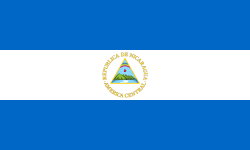- Flag of Nicaragua
-
Flag of Nicaragua
Use National flag and ensign 
Proportion 3:5 Adopted August 27, 1971 Design A horizontal bicolor triband of blue and white, with the national coat of arms centered on the middle band. The flag of Nicaragua was officially adopted on August 27, 1971 (first adopted on September 4, 1908). It is based on the flag of the United States of Central America and inspired by the Argentine flag.
Contents
Overview
The flag and the arms of Nicaragua in use today are the most similar to those used by the United Provinces of Central America. The triangle, volcanoes, rising sun, Cap of Liberty, and rainbow all appeared on the original emblem. The coat of arms used today contains the name of the state, Republica de Nicaragua, whereas in 1823 the title was Provincias Unidas del Centro de America. The decision to revert to the emblems used by the United Provinces of Central America was taken in 1908 and reflected Nicaragua's aspirations for the rebirth of the political entity formed by the 5 nations. Except for the text around the arms, the flag is very similar to that of the United Provinces of Central America. The 5 volcanoes represent the original 5 member states, the Cap of Liberty represents national freedom, and the rays of the sun and the rainbow are symbolic of the bright future.
Historical flags
 Flag of the Mosquito Coast, 1834 - 1860
Flag of the Mosquito Coast, 1834 - 1860
 Flag of the Mosquito Coast, 1860
Flag of the Mosquito Coast, 1860
 Flag of the Federal Republic of Central America, 1825 - 1841
Flag of the Federal Republic of Central America, 1825 - 1841
References
See also
External links
National Flag · Coat of Arms · National Anthem · National Flower · National Bird · National Tree
Flags of North America Sovereign states Dependencies and
other territoriesNational flags and coats of arms National flags National coats of arms Categories:- National flags
- National symbols of Nicaragua
- Rainbow flags
- Nicaragua stubs
- Flag stubs
Wikimedia Foundation. 2010.










